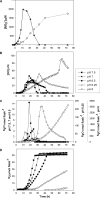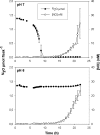Denitrification response patterns during the transition to anoxic respiration and posttranscriptional effects of suboptimal pH on nitrous [corrected] oxide reductase in Paracoccus denitrificans
- PMID: 20709842
- PMCID: PMC2950438
- DOI: 10.1128/AEM.00608-10
Denitrification response patterns during the transition to anoxic respiration and posttranscriptional effects of suboptimal pH on nitrous [corrected] oxide reductase in Paracoccus denitrificans
Erratum in
- Appl Environ Microbiol. 2010 Dec;76(24):8285
Abstract
Denitrification in soil is a major source of atmospheric N(2)O. Soil pH appears to exert a strong control on the N(2)O/N(2) product ratio (high ratios at low pH), but the reasons for this are not well understood. To explore the possible mechanisms involved, we conducted an in-depth investigation of the regulation of denitrification in the model organism Paracoccus denitrificans during transition to anoxia both at pH 7 and when challenged with pHs ranging from 6 to 7.5. The kinetics of gas transformations (O(2), NO, N(2)O, and N(2)) were monitored using a robotic incubation system. Combined with quantification of gene transcription, this yields high-resolution data for direct response patterns to single factors. P. denitrificans demonstrated robustly balanced transitions from O(2) to nitric oxide-based respiration, with NO concentrations in the low nanomolar range and marginal N(2)O production at an optimal pH of 7. Transcription of nosZ (encoding N(2)O reductase) preceded that of nirS and norB (encoding nitrite and NO reductase, respectively) by 5 to 7 h, which was confirmed by observed reduction of externally supplied N(2)O. Reduction of N(2)O was severely inhibited by suboptimal pH. The relative transcription rates of nosZ versus nirS and norB were unaffected by pH, and low pH had a moderate effect on the N(2)O reductase activity in cells with a denitrification proteome assembled at pH 7. We thus concluded that the inhibition occurred during protein synthesis/assembly rather than transcription. The study shed new light on the regulation of the environmentally essential N(2)O reductase and the important role of pH in N(2)O emission.
Figures





References
-
- Almeida, J. S., S. M. Júlio, M. A. M. Reis, and M. J. T. Carrondo. 1995. Nitrite inhibition of denitrification by Pseudomonas fluorescens. Biotechnol. Bioeng. 46:194-201. - PubMed
-
- Arai, H., M. Mizutani, and Y. Igarashi. 2003. Transcriptional regulation of the nos genes for nitrous oxide reductase in Pseudomonas aeruginosa. Microbiology 149:29-36. - PubMed
-
- Baumann, B., J. R. van der Meer, S. Mario, and J. B. Z. Alexander. 1997. Inhibition of denitrification activity but not of mRNA induction in Paracoccus denitrificans by nitrite at a suboptimal pH. Antonie Van Leeuwenhoek 72:183-189. - PubMed
-
- Bergaust, L., J. P. Shapleigh, Å. Frostegård, and L. Bakken. 2008. Transcription and activities of NOx reductases in Agrobacterium tumefaciens: the influence of nitrate, nitrite, and oxygen availability. Environ. Microbiol. 10:3070-3080. - PubMed
MeSH terms
Substances
LinkOut - more resources
Full Text Sources
Other Literature Sources
Molecular Biology Databases

